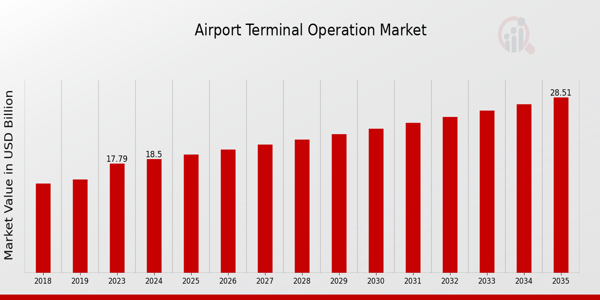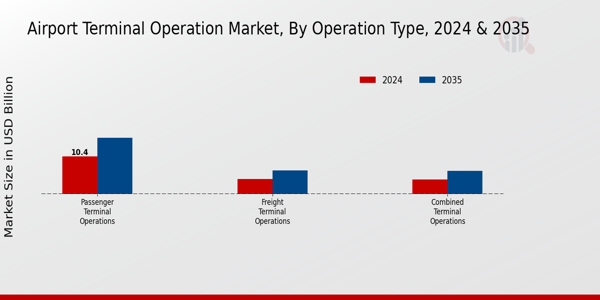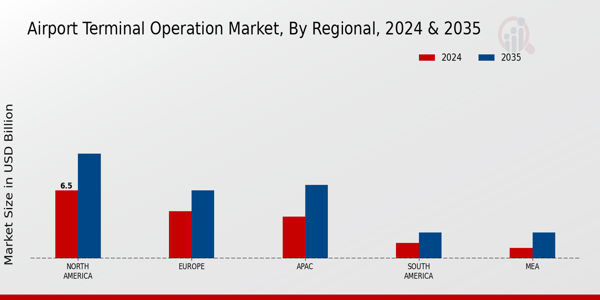Airport Terminal Operation Market Overview
The Airport Terminal Operation Market Size was estimated at 17.79 (USD Billion) in 2023.The Airport Terminal Operation Market is expected to grow from 18.5(USD Billion) in 2024 to 28.5 (USD Billion) by 2035. The Airport Terminal Operation Market CAGR (growth rate) is expected to be around 4.01% during the forecast period (2025 - 2035).

Source: Primary Research, Secondary Research, MRFR Database and Analyst Review
Key Airport Terminal Operation Market Trends Highlighted
Airport technology advances and rising passenger demand are driving the airport terminal operation market's notable expansion. Terminal operators are concentrating on improving operational efficiencies in order to efficiently handle higher passenger volumes as air travel continues to grow.
Modernization of airport infrastructure and the incorporation of smart technology, which optimize operations and enhance the entire traveler experience, are important industry drivers. In addition to improving service quality, the move toward automation and digitization in terminal administration is also significantly lowering operating expenses.
There are numerous opportunities to be explored within this evolving landscape. Airports are increasingly investing in eco-friendly practices and solutions, leading to opportunities in sustainable terminal operations.
The rising demand for seamless travel experiences presents a chance for technology providers to develop innovative solutions that enhance customer interactions, from check-in to boarding.
Additionally, the growing trend in e-commerce has opened avenues for airports to explore new services, such as increased logistics operations and drop-off centers for parcels, effectively expanding their service offerings. Trends in recent times indicate a strong shift toward passenger-centric services in airport terminals.
Airports are incorporating advanced biometric systems and contactless technologies, enabling faster and safer passenger processing. Moreover, the focus is expanding to cater to traveler preferences, such as enhanced retail experiences and improved amenities.
Collaborations between airlines and airport operators are becoming common in efforts to provide seamless connections both on the ground and in the air. These developments signify a move toward a more integrated and efficient travel ecosystem that meets the evolving expectations of today's travelers.
Airport Terminal Operation Market Drivers
Increasing Air Passenger Traffic
One of the most significant drivers of the Airport Terminal Operation Market is the continuous increase in air passenger traffic. The growing demand for air travel is primarily driven by rising disposable incomes, urbanzation, and the increasi ng propensity of individuals to travel for leisure and business purposes.
As economies expand, more people are able to afford air travel, leading to higher passenger volumes at airports worldwide. This influx of passengers necessitates enhanced airport terminal operations to manage throughput effectively, ensuring smooth check-in, security screening, and boarding processes.
Additionally, the demand for improved customer experiences and services in airports pushes the industry to innovate and adapt its operations. Consequently, airport operators are compelled to invest in advanced technologies and operational strategies to accommodate growing numbers, enhance service delivery, and maintain efficient terminal operations.
The expansion of existing terminals, alongside the construction of new ones, is integral to sustaining this growth and delivering a seamless travel experience, directly influencing the valuation of the market.
Technological Advancements in Airport Operations
The Airport Terminal Operation Market is witnessing rapid technological advancements that significantly enhance operational efficiencies. Innovations such as biometric screening, automated baggage handling systems, and AI-driven passenger flow management are transforming traditional airport operations.
These technological developments not only streamline processes but also improve the overall passenger experience by reducing wait times and increasing operational transparency. As technology continues to evolve, airports that adopt these innovations will likely gain a competitive edge, driving further growth in the market.
Government Investments in Airport Infrastructure
Governments around the world are increasingly recognizing the importance of robust airport infrastructure as a pillar for economic growth. Significant investments are being made in airport terminals to upgrade facilities, enhance security, and improve passenger services.
These investments not only aim to accommodate rising passenger numbers but also to support the tourism and trade sectors, which are vital for economic development. Such strategic government initiatives are essential for the growth of the Airport Terminal Operation Market.
Airport Terminal Operation Market Segment Insights
Airport Terminal Operation Market Operation Type Insights
The Airport Terminal Operation Market was broad and reflected various operation types, critical to the efficient functioning of air travel.
Within this sector, Passenger Terminal Operations represented the dominant force with a valuation of 10.4 USD Billion in 2024, which rises to 15.6 USD Billion by 2035, indicating its essential role in facilitating the movement of travelers globally.
This operation type catered to the majority of air traffic and reflected a considerable proportion of the overall market revenue, driven by increasing passenger volumes, growing tourism, and rising disposable income levels worldwide.
Freight Terminal Operations, valued at 4.1 USD Billion in 2024 and projected to increase to 6.5 USD Billion in 2035, also played a crucial role in the ogistics and supply chain sectors, emphasizing the importance of air freight in achieving timely deliveries of goods across borders.
As e-commerce continues to burgeon, the demand for freight terminal operations is expected to witness steady growth, highlighting its significant role in responding to consumer needs for rapid shipment services.
Moreover, Combined Terminal Operations, valued at 4.0 USD Billion in 2024 with an expected increase to 6.4 USD Billion in 2035, provided an integrated approach to handling both passenger and freight traffic within a single facility. This model offered operational efficiency and is increasingly favored in modern aviation infrastructure, accommodating diverse operational needs effectively.
The growth dynamics in the Airport Terminal Operation Market were influenced by several factors, including increasing urbanization, the expansion of airport infrastructure, advancements in technology, and enhanced customer experience initiatives.
However, challenges such as regulatory compliance, fluctuating fuel prices, and the need for sustainable practices present ongoing hurdles for market participants. Nevertheless, opportunities remain diverse, with innovations in automation, digitalization in operations, and improved safety protocols indicating that the market is poised for resilient growth.
As urban centers expanded and travel patterns evolved, the segmentation of operation types within the Airport Terminal Operation Market highlighted the adaptability and responsiveness needed to stay aligned with emerging trends and passenger expectations.

Source: Primary Research, Secondary Research, MRFR Database and Analyst Review
Airport Terminal Operation Market Service Type Insights
The Airport Terminal Operation Market is experiencing steady growth, driven by the demand for efficient and seamless passenger experiences. This market encompasses various service types that play essential roles in daily operations.
Ground Services are pivotal, ensuring the smooth handling of aircraft on the tarmac, which enhances overall operational efficiency. Passenger Services focus on improving traveler comfort through check-in, baggage handling, and amenities, thus significantly influencing passenger satisfaction and loyalty.
Cargo Services are also critical, as trade continues to expand, necessitating reliable logistics support within terminals. Meanwhile, Maintenance Services ensure that airport facilities and equipment remain in optimal condition, safeguarding security and operational continuity.
The ongoing market growth signifies increasing investments in improving service quality across these categories, aligning with the latest industry trends emphasizing automation, sustainability, and enhanced customer engagement.
As businesses adapt to rising passenger traffic and evolving technological landscapes, these service types are expected to become even more integral to the operational dynamics of the airport terminal sector.
Airport Terminal Operation Market Technology Insights
The Airport Terminal Operation Market, particularly in the technology segment, is poised for significant transformation as it evolves to meet the rising demands of efficiency and passenger convenience. Additionally, Baggage Handling Systems are vital, as they ensure prompt and secure handling of luggage, minimizing delays.
Biometric Systems are increasingly adopted for their capability to enhance security while speeding up passenger verification processes, making them a significant contributor to operational efficiency. Likewise, Flight Information Display Systems play a crucial role by providing real-time updates and enhancing the passenger experience.
These technological advancements not only improve operational efficiency but also represent a shift toward a more streamlined and secure airport experience, aligning with the broader trends of automation and digitalization in the airport terminal operations industry.
The growth of such technologies reflects changing traveler expectations and creates opportunities for innovation and enhanced services within the Airport Terminal Operation Market revenue landscape.
Airport Terminal Operation Market End User Insights
The Airport Terminal Operation Market is characterized by a diverse range of end users, which include Airlines, Airport Authorities, and Ground Handling Agencies. Airlines play a crucial role in this market, as they account for a significant proportion of the activity at terminals, where improvements in operational efficiency and customer experience are paramount.
Airport Authorities, responsible for managing airport operations, also dominate the market as they invest in technology and infrastructure to enhance passenger flow and streamline operations. Ground Handling Agencies are integral to ensuring the seamless interface between airlines and passengers, overseeing tasks such as baggage handling and aircraft servicing.
The growth of air travel, particularly post-pandemic, drives the need for advanced terminal operations, leading to new opportunities for innovation. Additionally, the focus on sustainability and the implementation of smart solutions present favorable prospects for all end users.
Market growth is supported by the ongoing recovery in air traffic and the demand for enhanced service quality at terminals, as highlighted by the steady advancement in Airport Terminal Operation Market statistics.
Airport Terminal Operation Market Regional Insights
The Regional segment of the Airport Terminal Operation Market was significant, with a valuation of 18.5 USD Billion expected in 2024. North America led this segment, valued at 6.5 USD Billion in 2024 and projected to reach 10.0 USD Billion by 2035, dominating due to high passenger traffic and advanced technology integration in airport operations.
Europe followed closely, with a valuation of 4.5 USD Billion in 2024, benefiting from robust infrastructure and regulatory support, increasing its value to 6.5 USD Billion by 2035. The APAC region was notable for its rapid growth potential, valued at 4.0 USD Billion in 2024 and expected to reach 7.0 USD Billion by 2035, driven by rising air travel demand.
South America and the MEA regions held smaller yet growing market shares, valued at 1.5 USD Billion and 1.0 USD Billion respectively in 2024, with aspirations to reach 2.5 USD Billion by 2035.
This overall market growth was supported by increasing air travel, the need for efficient terminal operations, and advancements in airport management technology, presenting opportunities for further development and investment in these regions.

Source: Primary Research, Secondary Research, MRFR Database and Analyst Review
Airport Terminal Operation Market Key Players and Competitive Insights:
The Airport Terminal Operation Market is characterized by its dynamic nature, influenced by various factors such as technological advancements, changing passenger expectations, and evolving regulations. As airports strive to enhance efficiency and improve the overall passenger experience, the market has seen a surge in innovation.
Companies operating within this space are increasingly adopting automated systems, advanced security solutions, and real-time data analytics to optimize terminal operations. This competitive landscape is driven by the need for seamless operations, effective resource management, and enhanced connectivity, with an emphasis on improving the traveler experience from check-in to boarding.
Dubai Airports has established itself as a leading player in the Airport Terminal Operation Market, capitalizing on its strategic geographic location and state-of-the-art infrastructure. With a robust focus on customer satisfaction, Dubai Airports has implemented various initiatives aimed at streamlining operations and enhancing passenger flow through its terminals.
The integration of smart technologies has bolstered its operational efficiency, allowing for quicker processing times and improved services. Furthermore, Dubai Airports' ability to engage in partnerships and collaborations fosters continuous improvement and innovation in the terminal experience, positioning it as a key competitor in the market.
On the other hand, Changi Airport Group is renowned for its commitment to excellence in passenger experience and operational efficiency within the Airport Terminal Operation Market. The company has gained recognition for its award-winning terminal facilities, which showcase a blend of cutting-edge technology and customer-centric design.
Changi Airport Group’s strength lies in its ability to adapt swiftly to market changes, ensuring high levels of service and operational performance. The group continually invests in infrastructure improvements and sustainable practices, reinforcing its reputation as a forward-thinking leader in the airport operations sector.
Its emphasis on leisure and retail experiences further differentiates it in the competitive landscape, attracting travelers from around the globe.
Key Companies in the Airport Terminal Operation Market Include:
- Dubai Airports
- Changi Airport Group
- Beijing Capital International Airport
- Heathrow Airport Holdings
- Sydney Airport
- Airport Authority Hong Kong
- Incheon International Airport Corporation
- O'Hare International Airport
- Fraport AG
- Los Angeles International Airport
- MactanCebu International Airport
- San Francisco International Airport
- Aeroports de Paris
Airport Terminal Operation Market Developments
Recent developments in the Airport Terminal Operation Market indicate a significant focus on enhancing passenger experience and operational efficiencies amid rising air travel demands. Dubai Airports has announced the expansion of its terminal facilities to accommodate increased passenger flow, while Changi Airport Group is implementing advanced technology for contactless check-ins.
Additionally, Beijing Capital International Airport is upgrading its systems to integrate real-time data analytics for improved operational decision-making. Heathrow Airport Holdings has moved towards greener operations, emphasizing sustainability in its infrastructure investments.
The Airport Authority Hong Kong has launched initiatives aimed at increasing air cargo efficiency, reflecting the growing logistics demands. In recent months, Sydney Airport has seen a surge in market valuation, positively impacting its operational capacity and investments.
Mactan-Cebu International Airport is also experiencing heightened growth in passenger traffic, prompting further developments. Notably, there have been discussions around potential mergers involving Los Angeles International Airport and other regional hubs, suggesting a trend toward consolidation within the market space.
As these companies continue to innovate and expand, their strategic moves are reshaping the competitive landscape of airport terminal operations globally.
Airport Terminal Operation Market Segmentation Insights
Airport Terminal Operation MarketOperation TypeOutlook
- Passenger Terminal Operations
- Freight Terminal Operations
- Combined Terminal Operations
Airport Terminal Operation MarketService TypeOutlook
- Ground Services
- Passenger Services
- Cargo Services
- Maintenance Services
Airport Terminal Operation MarketTechnologyOutlook
- Automated Check-In Systems
- Baggage Handling Systems
- Biometric Systems
Flight Information Display Systems
Airport Terminal Operation MarketEnd UserOutlook
- Airlines
- Airport Authorities
- Ground Handling Agencies
Airport Terminal Operation MarketRegionalOutlook
- North America
- Europe
- South America
- Asia Pacific
- Middle East and Africa
Scope:,,,,,,,,,,,,,
| Attribute/Metric Source: |
Details |
| MARKET SIZE 2023 |
17.79(USD Billion) |
| MARKET SIZE 2024 |
18.5(USD Billion) |
| MARKET SIZE 2035 |
28.5(USD Billion) |
| COMPOUND ANNUAL GROWTH RATE (CAGR) |
4.01% (2025 - 2035) |
| REPORT COVERAGE |
Revenue Forecast, Competitive Landscape, Growth Factors, and Trends |
| BASE YEAR |
2024 |
| MARKET FORECAST PERIOD |
2025 - 2035 |
| HISTORICAL DATA |
2019 - 2024 |
| MARKET FORECAST UNITS |
USD Billion |
| KEY COMPANIES PROFILED |
Dubai Airports, Changi Airport Group, Beijing Capital International Airport, Heathrow Airport Holdings, Sydney Airport, Airport Authority Hong Kong, Incheon International Airport Corporation, O'Hare International Airport, Fraport AG, Los Angeles International Airport, MactanCebu International Airport, San Francisco International Airport, Aeroports de Paris |
| SEGMENTS COVERED |
Operation Type, Service Type, Technology, End User, Regional |
| KEY MARKET OPPORTUNITIES |
Automation and AI integration, Sustainable terminal designs, Enhanced passenger experience technology, Smart baggage handling systems, Data analytics for operations optimization |
| KEY MARKET DYNAMICS |
Growing air travel demand, Technological advancements in operations, Government investments in infrastructure, Increasing focus on passenger experience, Sustainability and environmental regulations |
| COUNTRIES COVERED |
North America, Europe, APAC, South America, MEA |
Frequently Asked Questions (FAQ) :
The Airport Terminal Operations Market was valued at 18.63 USD Billion in 2024.
By 2035, the Airport Terminal Operations Market is anticipated to reach a valuation of 30.0 USD Billion.
The market is expected to grow at a CAGR of 4.43% from 2025 to 2035.
North America dominated the market with a valuation of 7.5 USD Billion in 2024.
Passenger Services were valued at 7.5 USD Billion in 2024.
The Baggage Handling segment is expected to reach a valuation of 6.7 USD Billion in 2035.
Major players include Changi Airport Group, Fraport AG, and London Heathrow Airport Holdings.
Cargo Operations were valued at approximately 3.93 USD Billion in 2024.
The APAC region is expected to grow to 7.0 USD Billion by 2035.
Security Services are projected to reach a valuation of 4.8 USD Billion by 2035.
















